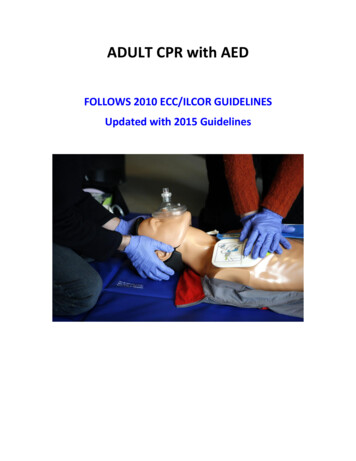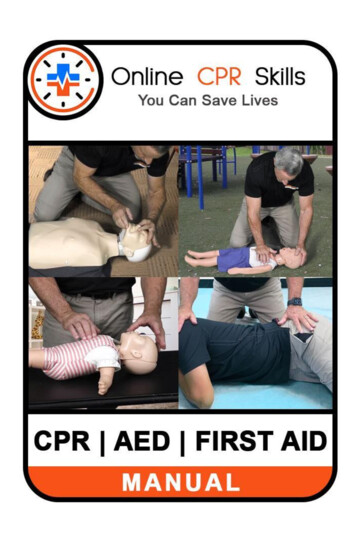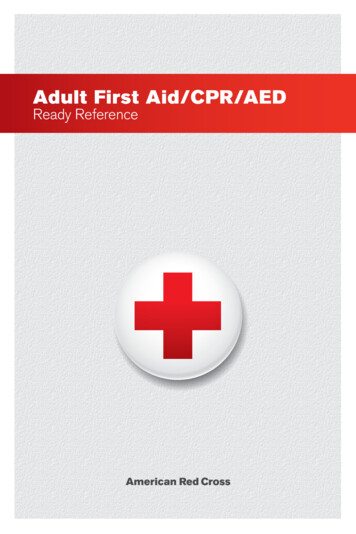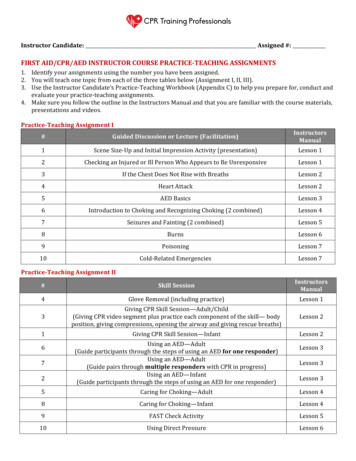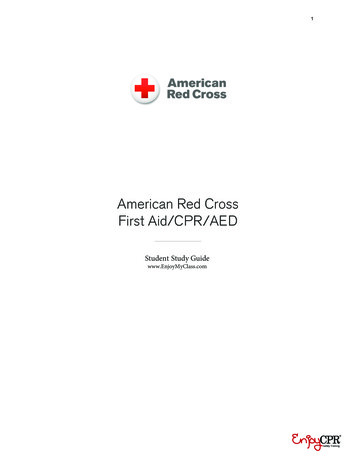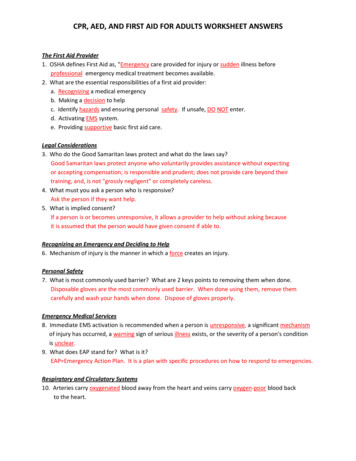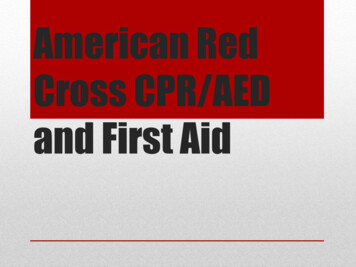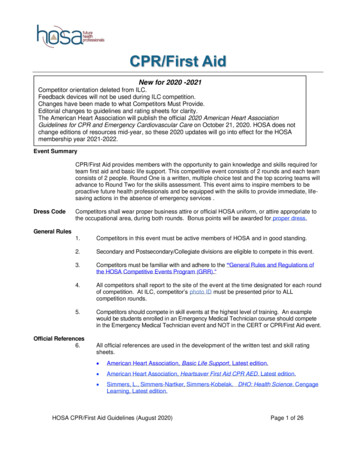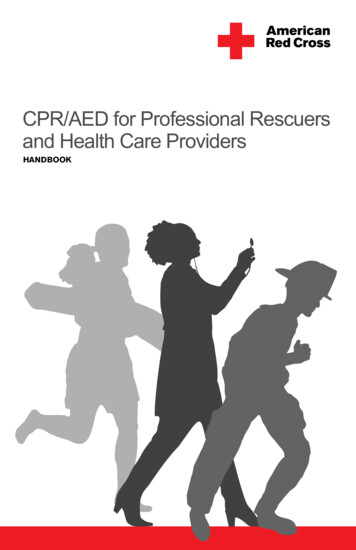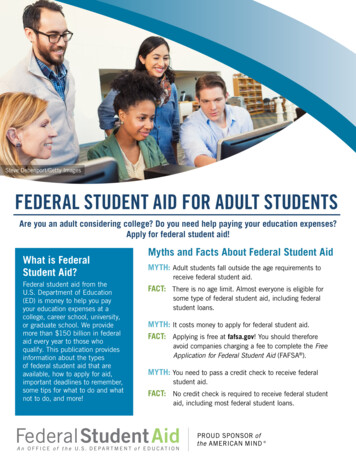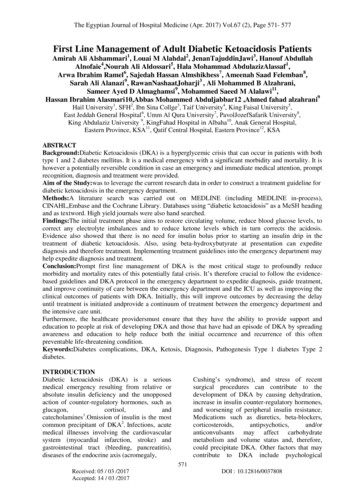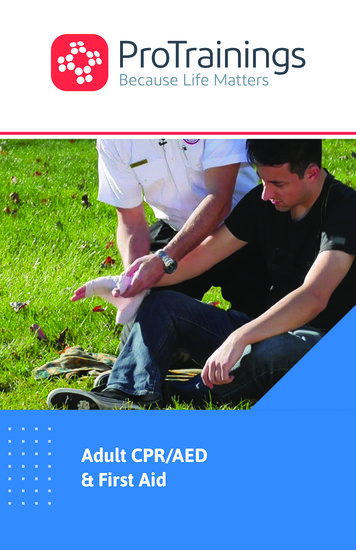
Transcription
Adult CPR/AED& First Aid
The purpose of this booklet is to provide a brief review of course contentfor a specific ProTrainings course.Visit www.protraininings.com to view the full course curriculum. This material is powered by the ProTrainings. All content 2021, ProTrainings, LLC. All rights reserved.Revised: May 2021
COURSE CONTENT04Overcome the 5 fears that preventrescue20Musculoskeletal Injuries21Burns21Eye Injuries22Diabetic Emergencies05Prevention of cardiovascular disease06Recognition and action steps forsuspected heart attack and stroke07Universal Precautions22SeizuresCPR for adult22Poison Control12AED for adult23Bites and Stings14Conscious and unconscious chokingfor adult23Allergic Reactions24Asthma17Bleeding Control24Epinephrine Injection18Shock Management25Heat and Cold Emergencies18Secondary Survey27Special Considerations19Head, Neck and Back Injuries29Opioid Overdose19Concussions30Moving People08BASIC TERMSGood Samaritan Law states that a personacting in good faith, rendering reasonable first aid,will not be held accountable for damages to thatperson unless gross willful misconduct is used. Thisperson must not have a legal duty to respond orcomplete the first aid.Negligence When you have a duty to respondand you fail to provide care or give inappropriatecare, and your failure to provide care or inappropriate care causes injury or harm.Universal Precautions Using gloves, masks,Consent a patient allowing you to give first aidgowns, etc. for every patient every time when there isa possibility of coming in contact with any body fluids.Informed consent you informing the patientClinical Death The moment breathing andof consequences, and then the patient givingpermission for you to give first aid.Implied consent when a patient isunconscious, it is given that if the person wereconscious, they would request care.Abandonment initiating care and then stopping without ensuring that the person has samelevel or higher care being rendered.Adult CPR/AED & First Aidheartbeat stop. Typically, a person has a highlikelihood of being revived without much cellulardamage when clinically dead for approximately 0-6minutes. Within 6-10 minutes, brain cell damage ishighly likely.Biological Death Irreversible damage tobrains cells and tissues. If a person has beenclinically dead for 10 minutes or more, therewill be irreversible cell damage. Resuscitation isunlikely but not impossible.3
THE FIVE FEARS1 FEAR OF DISEASESolution: Universal precautions. Whenever the possibilityof coming in contact with bodily fluids exists, wear personal protective equipment for every patient, every time.2 FEAR OF LAWSUITSSolution: Good Samaritan laws. States have laws thatprotect people from legal action who act in good faithto provide reasonable First Aid when the rescuer doesnot have a legal duty to respond.3 FEAR OF UNCERTAINTYSolution: Emphasis is placed on the role of CPR notmerely on the number sequences. Even if numbers areforgotten, remember to push hard and push fast. Thisemphasizes the simplicity of basic life support.4 FEAR OF HURTING A PATIENTSolution: Patients who are clinically dead can only behelped, not made worse with resuscitation efforts.5 FEAR OF UNSAFE SCENESolution: Never enter an unsafe scene! Rescuers are nouse to patients if they become patients themselves.Adult CPR/AED & First Aid4
CARDIOVASCULAR DISEASECardiovascular disease is the number onekiller in the United States. The Center forDisease Control reports that in the UnitedStates over 600,000 people die each year fromcardiovascular disease.CONTROLLABLE RISK FACTORS cigarette smoking high blood pressure obesity lack of exercise high blood cholesterol levels uncontrolled diabetes high fat diet high stressUNCONTROLLABLE RISK FACTORS racehereditysexageCardiovascular disease causes damage to the heart and blood vessels.Cardiovascular disease often leads to heart attack or stroke. The best way to survive aheart attack or stroke is to never have one. The key for cardiovascular disease is to focuson prevention.You can give yourself the best chance of preventing cardiovascular disease with proper nutrition, consistent physical activity, weight management, stress management, eating properfats and oils, and quitting smoking.Adult CPR/AED & First Aid5
HEART ATTACKSIGNS AND SYMPTOMS MAY INCLUDE Chest discomfort-pressure, tightness, thatmay radiate to jaw and arms. Nausea Sweating Shortness of breath Denial Feeling of weaknessWomen present more with shortness of breath, extreme fatigue, or flu-like symptoms.About a third of women experience no chest pain.TREATMENTRecognize the signs and symptoms of a heart attack, activate EMS, havepatient remain in a position of comfort, offer 1 adult dose aspirin, and keepthe patient calm and quiet.STROKEStroke is the 3rd leading cause of death in the UnitedStates. Strokes can be one of two types:ischemic a clot in a blood vessel that restricts or obstructs blood flow to the brain;hemorrhagic a blood vessel that ruptures and preventsblood flow to the brain. In either case, the brain is deprivedof oxygen and tissue starts to die. The longer the stroke goesunrecognized and untreated, the more damage is done.SIGNS AND SYMPTOMS MAY INCLUDE Numbness or weakness of the face,arm or leg, especially on one side ofthe body. The acronym FAST helps inassessing a stroke:F– facial droop, A– Arm drift, S– Speech,T– Time Confusion, trouble speaking orunderstanding Trouble seeing in one or both eyes Trouble walking, dizziness, loss ofbalance or coordination Severe headache with no known causeTREATMENTRecognize the signs and symptoms of a stroke, activate EMS, give nothing to drink or eat, andkeep the patient calm and quiet. Monitor patient and be prepared to start CPR if necessary.Adult CPR/AED & First Aid6
CHAIN OF SURVIVALThe earlier these steps take place in an emergency, the better the chance of a patient’ssurvival.Recognition andActivation of EMSHigh Quality CPRDefibrillationAdvanced CarePost Cardiac ArrestCare and RecoveryUNIVERSAL PRECAUTIONSPUTTING GLOVES ON:Use disposable gloves when providing first aid care. If you have a latex allergy use a latexalternative such as nitrile or vinyl. Before providing care, make sure the gloves are not rippedor damaged. You make need to remove rings or other jewelry that may rip the gloves.REMOVING GLOVES:Remember to use skin to skin and glove to glove. ➊ Pinch the outside wrist of the othergloved hand. ➋ Pull the glove off turning the glove inside-out as you remove it. ➌ Hold it inthe gloved hand. ➍ Use the bare hand to reach inside the other glove at the wrist to turn itinside out trapping the other glove inside. Dispose of gloves properly. If you did it correctly,the outside of either glove never touched your exposed skin.USE A RESCUE MASK OR FACE SHIELD:If you have to provide rescue ventilations, use a rescue mask or face shield that has a oneway valve. To prevent exposure, avoid giving direct mouth to mouth ventilations.Adult CPR/AED & First Aid7
CPRCHECK THE SCENEKey Questions to ask: Is it safe for me to help? What happened? How many patients are there? Am I going to need assistance from EMS? Do I have my personal protective equipmentready to use?CHECK THE PATIENT Tap and shout. Is there any response? While checking for responsiveness, look fornormal breathing by looking at the person’schest and face. Is the patient breathingnormally? Agonal respirations are not normalbreathing. They would be characterized asoccasional gasps. The chest does not rise.ACTIVATE EMS – CALL 911Send someone to call and tell them to come back. The caller should give dispatch thepatient’s location, what happened, how many people are injured, and what is being done.If alone and no one is available: PHONE FIRST for adults and get the AED.Return to start CPR and use the AED for allages. CARE FIRST for children and infants byproviding about 5 cycles or 2 minutes of CPRbefore activating the emergency responsenumber. CARE FIRST for all age patients of hypoxic(asphyxial) arrest (ei., drowning, injury, drugoverdose).Adult CPR/AED & First Aid8
CPRCOMPRESSIONSIf the victim is unconscious with no normal breathing,begin chest compressions. Give 30 chest compressions at a rate of 100-120compressions per minute for all ages. Hand placement for compressions:Adult – Place heel of hand of the dominant handon the center of the chest between the nipples. Thesecond hand should be placed on top. Compress2-2.4 inches deep.AIRWAY Open Airway using head tilt chin liftLook in the mouth to make sure the airway is clear.If you see any foreign object, sweep it out right away.BREATHING Give 2 breaths lasting 1 second each. Watch for chestrise and fall.Note: If not using a rescue mask, make sure you make aseal over the mouth on an adult or child and pinch the noseclosed each time you give a breath. On an infant, make sureto cover the mouth and nose with your mouth. Continue cycles of 30compressions to 2 breathsuntil an AED arrives, advancedmedical personnel take over,the patient shows signs of life,the scene becomes unsafe,or you are too exhausted tocontinue.Adult CPR/AED & First Aid9
CPRCOMPRESSIONSHand placement for compressions:ADULTPlace heel of hand of the dominant hand on the center of thechest between the nipples.The second hand should beplaced on top. Compress 2-2.4inches deep.CHILDINFANTHand placement is the same asadult. You may use one hand inthe center of the chest betweenthe nipples or a very smallchild. Compress at least 1/3 thedepth of the chest.Place two fingers on the center of the chest between thenipples. Compress at least1/3 the depth of the chest.AIRWAYOpen Airway using head tilt chin lift Look in the mouthto make sure the airway is clear. If you see any foreignobject, sweep it out right away.BREATHINGGive 2 breaths lasting 1 second each. Watch for chest riseand fall.Note: If not using a rescue mask, make sure you make aseal over the mouth on an adult or child and pinch thenose closed each time you give a breath. On an infant,make sure to cover the mouth and nose with your mouth.Continue cycles of 30 compressions to 2 breaths until anAED arrives, advanced medical personnel take over, thepatient shows signs of life, the scene becomes unsafe, oryou are too exhausted to continue.Adult CPR/AED & First Aid10
CPR SUMMARYD Check the Scene for SafetyD Check the person for responsiveness and normal breathingD Call 911D Give 30 Chest CompressionsRate of 100-120 per minute, 2-2.4 inches deepD Open the AirwayD Give 2 BreathsD Continue cycles of 30 compressions to 2 breathsAdult CPR/AED & First Aid11
AED- AUTOMATED EXTERNAL DEFIBRILLATORCLINICAL DEATHBreathing and heartbeat have stopped:0-6 minutesBIOLOGICAL DEATHCellular death hasoccurred: 10 minutesThe AED analyzes the heart’s rhythm, states whether ashock is advised and then powers up, the operator thenpushes a button that will deliver the shock. Each minute that defibrillation is delayed the chance of survival is reduced by 10 percent.After 10 minutes few people are resuscitated. Early defibrillation increases survival rates to greater than 50%. Rescuers should begin chest compressions as soon as possible, and use the AED as soonas it is available and ready. If you are giving CPR to a child or infant and the available AED does not have child padsor a way to deliver a smaller dose, it is still recommended to use the AED even with adultpads. With adult pads for a small child or infant, you would place one pad on the center ofthe chest and the other on the center of the back between the shoulder blades.AED CONSIDERATIONS:D Remove a patient from standing water, such as in a puddle, before AED use. Rain, snow,or a damp surface is not a concern.D Patient should be removed from a metal surface if possible.D Slightly adjust pad placement so as not to directly cover the area if the patient has anobvious bump or scar for a pacemaker.D Remove medication patches found on the patient’s chest with a gloved hand.D Never remove the pads from the patient or turn the machine off.Adult CPR/AED & First Aid12
AED AUTOMATED EXTERNAL DEFIBRILLATOR Adult CPR/AED & First AidTurn the machine on.Bare the chest. Dry it off if it is wet. If there is excessivehair you may need to shave it off.Place one pad on the patients upper right chest abovethe nipple. Place the other pad on the patients lower leftribs below the armpit.**Follow the directions shown on the pads for the AED pad placement.Make sure pads are pressed down firmly.Follow AED prompts.Stand Clear. Do not touch the patient while the AEDanalyzesIf the AED says, “Shock advised, charging ,” shout,“Clear” and make sure no one is touching the patient.Push the shock button when the AED tells you to.If no shock is advised give CPR if the patient is notmoving and not breathing.As soon as the shock has been delivered, give 30 chestcompressions followed by 2 breaths. Continue cycles of30:2 until you see signs of life.The AED will reanalyze every 2 minutes and prompt fora shock if needed.13
CONSCIOUS CHOKING Ask, “Are you choking? If a person is unable to cough, breath or speak, activate EMS Stand behind the victim with one foot in-between the victims feet and your otherfoot behind you. Place the flat side of your fist just above the patients belly button. Grab the backof your fist with your other hand. Administer abdominal thrusts, pulling inward and upward, until the object comesout or the patient becomes unconscious.SPECIAL CIRCUMSTANCES: If the patient is pregnant or too large to reach around, give chest thrusts instead.Adult CPR/AED & First Aid14
UNCONSCIOUS CHOKING Activate EMS, send someone to call 911 Give 30 chest compressions Adult CPR/AED & First AidIf you are giving someone abdominal thrusts and theperson goes unconscious, lower the patient safely tothe ground.Open the airway and check the mouth for a foreignbody. If something is seen sweep it out with a finger.Use the pinky finger for an infant.Attempt rescue breaths. If breaths do not make thechest rise, reposition head and reattempt rescuebreaths.15
UNCONSCIOUS CHOKING Adult CPR/AED & First AidGive 30 chest compressions.Open the airway and check the mouth for aforeign body. If something is seen sweep it outwith a finger. Use the pinky finger for an infant.Give 2 breaths.If breaths do not make the chest rise, repositionhead and reattempt rescue breaths. Continuecompressions, foreign body check, breathingattempts until air goes in and chest rises.If victim has no pulse and is not breathingnormally, continue CPR with cycles of 30compressions to 2 breaths.16
BLEEDING AND SHOCKBLEEDING CONTROLCapillary bleeding is usually not seriousand is characterized by oozing blood thatis easily stopped. Venous bleeding steadilygushes larger amounts of blood, but canusually be stopped with direct pressure.Arterial bleeding is usually spurting and isthe most serious because a large amount ofblood can be lost quickly. Inspect the wound. Look for the area were the bleeding is coming from. Apply gloves. Use direct pressure on the wound using an absorbent pad or gauze. Add more gauzeor padding if necessary. Make a pressure bandage by wrapping a roller gauze or elastic bandage around thewound to maintain bleeding control. If severe bleeding is not controlled, consider using a tourniquet. Activate EMS if severe bleeding is present, use direct pressure and apply pressurebandage. If wound is minor, wash and apply an antibiotic ointment, then bandageas needed.NOSE BLEEDS (EPISTAXIS) Treatment: Pinch nose, tilt the head forward, and apply a cold pack to bridge of nose.EVISCERATION (DISEMBOWELMENT) Treatment: Activate EMS, cover with sterile or clean moist dressing. Do notattempt to push bowl or organs back into place. Keep patient warm, care forshock, check and correct ABC.AMPUTATION Treatment: Activate EMS, control bleeding with direct pressure with bulky dressing.If amputated part can be found wrap in clean or sterile dressing and place in plasticbag. Put bag in container of ice and water. Care for shock, check and correct ABC.Do not soak amputated part in water or allow it to freeze by putting it directly on ice.DENTAL EMERGENCIES Treatment: For bleeding, apply a moistened piece of gauze with direct pressure tothe area. Be careful not to block the airway or cause a choking hazard. If teeth areknocked out, avoid handling by the root end, store in coconut water or milk. Applya cold compress to the outside of the mouth, cheek, or lip near the injury to keepany swelling down and relieve pain. If life threatening conditions exist, call 911 andprovide appropriate care. Otherwise, seek medical treatment and dental care as soonas possible.Adult CPR/AED & First Aid17
FIRST AID CARESHOCK Shock is the body’s inability tocirculate oxygen to the vital organs.Signs & Symptoms: restlessness,dizziness, confusion, cool moist skin,anxiety, delayed capillary refill time,and weakness.Treatment: Recognize, Activate EMS,keep calm, give nothing to eat or drink,maintain body heat, raise the legs if nospinal injury or fracture of the legs.SECONDARY SURVEYThe secondary survey is an organized way to check a conscious person for conditions whichmay not be visible or immediately life threatening, but may become so if not cared for.Call 911 for any altered level of consciousness, signs of shock, or potential head, neck orback injuries. Perform a head to toe exam:Look from head to toe for:D DeformitiesD BurnsD ContusionsD TendernessD AbrasionsD LacerationsD PenetrationsD SwellingHead soft spots, blood, look at the eyes,blood or loose teeth in the mouth, blood or fluid from nose or ears, bruising of the eyes andbehind the earsNeck bleeding, pain, tenderness, bruising, open woundsChest blood, accessory muscle breathing, broken ribs, or open woundsAbdomen bleeding, abdominal evisceration, guarding, tenderness, bruisingPelvis bleeding, instabilityLegs bleeding, bruising, deformity, open wounds, sensation and movementArms bleeding, bruising, deformity, open wounds, distal sensation and movementAdult CPR/AED & First Aid18
FIRST AID CAREHEAD, NECK AND BACK INJURIESCommon Causes are: Motor Vehicle accidentsPedestrian-vehicle collisionsFallsBlunt traumaDiving accidentsAny trauma leaving the patientunresponsiveSigns and symptoms include: Bruising around the eyes and behindthe earsIrregular or abnormal breathing patternsAltered mental statusUnconsciousness HeadachePain, pressure, stiffness in the back orneck areaInability to move the arms or legsNumbness or tingling in the extremitiesTreatment: Activate EMS, do not move the patient unless life threatening danger arises,minimize movement, check and correct ABC.CONCUSSIONSigns and Symptoms include: DizzinessInability to track movement with eyesBlurred visionLoss of balance ConfusionAcute memory lossDazed lookNauseaTreatment: Activate EMS, let patient sit inposition of comfort, monitor patient for lifethreatening issues, check and correct ABC.Concussion in sports: If a player shows signsof having a concussion, the player is notallowed to go back to play until cleared bya physician.Adult CPR/AED & First Aid19
FIRST AID CAREMUSCULOSKELETAL INJURIESSprains and strains:A sprain is an overextended ligament.A strain is an overextended muscle.In either case, a minor sprain or strainis usually not serious. A more seriousstrain or sprain may show the samesigns as a fracture and require medicalattention. Sprain or strain signs include: Pain upon movementTendernessMinor swelling or bruisingTreatment: RICE - Rest the injured area, Ice for 10-15 minutes every hour, Compress bywrapping with an ACE or elastic bandage, Elevate the injured area above the person’sheart level.Fractures: If patient is not to able to move the body part, treat as a fracture.Consider the mechanism that caused the injury.Look for deformity, open wounds, tenderness, significant swelling, discoloration,bruising, crepitus (a grating sensation), and loss of movement.Cover any open wounds with dry clean dressings, but do not apply pressure overpossible fracture.General splinting is not recommended. Stabilize fractures in the position found.Splinting may be appropriate if there will be an extended time for EMS response,EMS is not available, or an individual will be transporting the patient to a hospital.Treatment: Activate EMS if necessary, manually stabilize the affected body part,do not attempt to straighten, use ice to minimize swelling.Adult CPR/AED & First Aid20
FIRST AID CAREBURNSFirst Degree PainRed SkinSwellingSecond Degree PainBlisteringWhite or Red SkinBody fluids leaking from the burn siteThird Degree Both numbness is burned area and severe pain in surrounding areaMulticolored skin, black, white, gray, and redSevere body fluid lossTreatment: Stop the burning. Cool burn with water, cover with dry sterile dressing (forchemical burns, flush with water for 15-20 minutes). For 1st and 2nd degree burns,activate EMS if severe conditions exist. For 3rd degree burns, electrical burns, andchemical burns activate EMS immediately. For electrical burns, look for entrance andexit burns. Care for shock, check and correct ABC.EYE INJURIES Burns stop the burning, bandage botheyesChemical flush with warm water for15-20 minutes and bandage both eyesPenetrating Trauma Do not remove.Bandage the object into place, place acup over object, and cover both eyes.Treatment: Activate EMS if severe conditions exist. Seek professional medical treatmentfor all forms of eye injuries.Adult CPR/AED & First Aid21
FIRST AID CAREDIABETIC EMERGENCIESSigns & Symptoms : Altered level ofconsciousnessPersonalitychangesIrritability WeaknessDizzinessDifficultybreathingCool, clammy skinTreatment: Give sugar if conscious. If unconscious or condition does not improve, activateEMS, check and correct ABC.SEIZURESSigns & Symptoms : Altered level of consciousnessUncontrollable shakingStiffnessTreatment: Activate EMS if the reason for the seizureis unknown or it lasts for more than 5 minutes.Protect patient from further harm, place nothingin the mouth, and do not try to restrain the patient. After seizure ends, open the airway,check and correct ABC, and consider moving patient into the recovery position if patientis unconscious and breathing.POISON CONTROLThe most important point for poisoning is to prevent itfrom happening. Store poisons, like cleaning products andmedications, out of reach of children. Use cabinet anddrawer safety locks.Signs & Symptoms Open bottles ofmedication or cleaningproducts near the victimAltered level ofconsciousnessHallucinations Burning sensation inthe chest and throatHeadacheExcessive sweating Difficulty breathingNausea and vomitingSevere abdominalcrampingBurns, stains, or bluetint around the mouthTreatment: Activate EMS and call Poison Control Services, 1-800-222-1222. Follow theirdirections.Adult CPR/AED & First Aid22
FIRST AID CARESNAKEBITESBites from poisonous snakes can be deadly if not treated quickly. Because children have asmaller body size, they are at higher risk for death or serious complications.Getting the victim advanced medical care and into an emergency room as quickly aspossible is most important. A person’s life can be saved and serious effects avoided with theright antivenom and quick action.Signs & SymptomsBleeding from wound, Blurred vision, Burning of the skin, Convulsions, Dizziness, Excessivesweating, Fainting, Fang marks in the skin, Loss of muscle coordination, Nausea andvomiting, Numbness and tingling, Severe pain, Skin discoloration, Swelling at the site ofthe bite, WeaknessTreatment: Activate EMS, apply a pressure immobilization bandage, keep injured area stilland below the level of the heart.JELLYFISH STINGS Jellyfish stings should be washed with vinegar as soon as possible for at least 30seconds, to inactivate the venomAfter washing well with vinegar, immerse affected area in hot water to helpreduce painALLERGIC REACTIONSAllergic reaction can happen because of food, drugs, poisons, plants, inhalation or insect stings. Altered level of consciousnessBurning sensation in the chest and throatDifficulty breathingNausea and vomitingSevere abdominal crampingRashes/HivesTreatment: Activate EMS, place in position of comfort. Look for obvious bites and stings. Ifthe patient has a prescribed Epi-pen, assist patient to utilize the device.Adult CPR/AED & First Aid23
FIRST AID CAREASTHMASigns & Symptoms Shortness of breath or wheezingLeaning forward to breathUnable to make noise or speakBlue lips and fingernailsMoist skinRapid, shallow breathingTreatment: Activate EMS and keep patient calm. Place in position of comfort. Ask aboutallergies, asthma, COPD or other medical conditions. If the patient has a prescribed inhaler,assist patient to utilize the device. Check and correct ABC.EPINEPHRINE INJECTIONEpinephrine is the first line of defense whenit comes to treating anaphylaxis. The soonerit’s administered, the less severe the allergicreaction will typically become. Anytime anEpiPen or other auto injectable brand deviceis used, 911 must be called. A first Aid providercan only assist a person in using their ownprescribed EpiPen. There may be exceptions,such as at a camp or school, where a first a provider may have authorization to use anEpiPen that is part of the First Aid equipment.To administer an epi-pen: Remove the safety cap.Grip the epi-pen in your hand with the tip pointing downward. Never put your thumb,fingers or hand over the tip.Firmly push the tip into the person’s outer thigh until the pen clicks. The needle will gothrough clothing. Keep the auto-injector firmly pushed against the thigh at a 90 angle.Hold it there for three seconds.Pull the EpiPen straight out of the leg. Make sure not to pull out at an angle as thiscould cause a lot of pain and bleeding. If blood comes out, the drug may also comeout and reduce its effectiveness.Rub the area for about 10 seconds just to help drug absorption within the muscle ofthe leg.A second EpiPen may be administered if the symptoms continue or recur and there isa delay in EMS response of more than 5-10 minutes.Adult CPR/AED & First Aid24
FIRST AID CAREHEAT RELATED EMERGENCIESHEAT CRAMPS Faintness, dizzinessExhaustionPossible nausea and vomitingNormal mental statusSevere muscle cramps/painTreatment: Get patient out of the hot environment, cool the patient, remove tight clothing,and give water if tolerated.HEAT EXHAUSTION Moist and clammy skinPaleWeak, dizzy or faintHeadacheNausea and vomitingTreatment: Get patient out of the hotenvironment, remove clothing as necessary,gently cool the patient, give water iftolerated. Immerse the persons full body incool water if it can be done safely, keepingthe head above water. If patient does notimprove or becomes unconscious, activateEMS, check and correct ABC.HEAT STROKE Unconscious or nearly unconsciousDry or wet skin, usually redVery high body temperatureTreatment: Activate EMS immediately, get patient out of the hot environment, check andcorrect ABC, remove clothing as necessary, gently cool the patient, give nothing to drink oreat. Immerse the persons full body in cool water if it can be done safely, keeping the headabove water.Adult CPR/AED & First Aid25
FIRST AID CARECOLD RELATED EMERGENCIESFactors that affect onset Weather severityAgePre-existing medical conditionAlcohol or drug consumptionClothingHYPOTHERMIAHypothermia tends to progress in stages starting from mild signs to severe. The earlier signsare recognized and treated, the better the outcome. ShiveringFeeling of numbnessSlow breathingSlow pulseSlurred speechDecreased levels of consciousnessHard, cold, painless body partsDeathTreatment: Get patient out of cold environment. Gently rewarm by removing wet clothingand covering patient with a dry blanket. If patient does not improve, shows decreased levelof consciousness or becomes unconscious, activate EMS.FROST-BITE Waxy looking, discolored, numb,swollen extremities (usually fingersand toes) after prolonged exposureto cold.Blisters may occur in severe cases.Treatment: Seek immediate professional medical help. Do not rub the affected area. Do notrewarm area if chance of refreezing exists. Rewarm with warm water, not hot.Adult CPR/AED & First Aid26
SPECIAL CONSIDERATIONSSPECIAL CONSIDERATIONS FOR HYPOTHERMIAIf the victim is unresponsive, not breathing,and suspected to be in hypothermia, followthe normal steps for CPR and take a fewextra steps. Activate EMS and begin CPR without delay AED should be used as normal Do not wait to check the victim’s temperature Do not wait until the victim is rewarmed to start CPR Wet clothes should be removed from the victim to prevent further heat loss Shield the victim from wind or cold If the person is breathing, rewarm and monitor the person until EMS arrives. Avoidrough movement and handle person gently. Passive warming, such as warm blankets and heat packs, can be used until activewarming is available with advanced medical care.SPECIAL CONSIDERATIONS FOR PREGNANCY The same skills and techniques for AdultCPR need be followed. The focus needs tobe on providing high quality CPR for mother.Because of potential interference with maternalresuscitation, fetal monitoring should not beundertaken during cardiac arrest in pregnancy. Because pregnant patients are more prone tohypoxia, oxygenation and airway managementshould be prioritized during resuscitation fromcardiac arrest in pregnancy.Adult CPR/AED & First Aid27
SPECIAL CONSIDERATIONSSPECIAL CONSIDERATIONS FOR DROWNINGWater does not need to be “pumpedout” of the lungs or stomach of adrowning victim. The routine use ofabdominal thrusts or other techniquesto remove water from drowning victimsis unnecessary, potentially dangerous,and not recommended.Most victims do no
Adult CPR/AED & First Aid 3 04 Overcome the 5 fears that prevent rescue 05 Prevention of cardiovascular disease 06 Recognition and action steps for suspected heart attack and stroke 07 Universal Precautions 08 CPR for adult 12 AED for adult 14 Conscious and unconscious choking for adult 17 Bleeding Control 18
